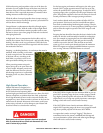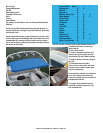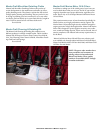
In most environments, a thorough clean-
ing will be needed approximately every
two (2) years.
e fabric can be cleaned while still in
the boat. When cleaning, it is important
to observe the following:
• Always use a natural soap—never
detergent.
• Water should be cold to lukewarm,
but never more than 100 degrees.
• Air dry only. Never apply heat to the
fabric.
Begin by brushing o loose dirt, and
then hose down the material. Prepare
a cleaning mixture of water and a mild,
natural soap that is free of detergents.
Use a so-bristle brush to clean, allow-
ing the soap to soak in. Rinse thoroughly and allow the fabric to
thoroughly air dry.
If stubborn stains persist, you can use a diluted chlorine bleach/
soap mixture for spot cleaning of mildew, roof run-o and other
similar stains. Please keep in mind that chlorine bleach will not
change the color of the fabric, but chlorine bleach will eventu-
ally break down the ber of any fabric. erefore, this cleaning
method should be used as infrequently as possible.
e cleaning mixture should be mixed as follows:
• Four ounces (one-half cup) of chlorine bleach.
• Two ounces (one-fourth cup) of natural soap.
• One gallon of water.
Clean with a so-bristle brush and allow the mixture to soak no
longer than twenty (20) minutes. Rinse thoroughly and allow to
completely air dry. Repeat if necessary.
If the top or boat cover is suitable in size for a washing machine,
these steps should be followed:
• Use only natural soaps—no detergent.
• Wash and rinse in cold water.
• Air dry. (Never put the fabric in a dryer.)
As part of the nishing process, the material has been treated
with a uorocarbon nish, which enhances water repellency.
is nish is designed to last for several years, but it must be
replenished aer a thorough cleaning. Based on test results, the
manufacturer recommends 303 High Tech Fabric Guard™ as the
preferred re-treatment product.
Aer cleaning and air drying, apply 303 in a thin, even coat.
When it has dried, apply a second thin, even coat. ese two (2)
light coatings are more eective in restoring fabric water resis-
tance than a single heavy coating. Keep in mind that 303 High
Tech Fabric Guard™ will work only as well as it is applied. is
means that the fabric must be free of dirt and detergents or the
Fabric Guard will wash away with the dirt particles.
Fabrics should be retreated aer thorough cleaning or aer ve
(5) years of use.
Enclosed Head
An option on some models is the enclosed, portable head. is
convenience should be emptied on-shore within an acceptable
holding tank, septic system or sewer. It should never be emptied
within the boating body of water or on-shore, except in an ap-
proved receptacle!
Aer thoroughly cleaning with a mild detergent, add a neutral-
izing chemical made especially for portable heads, such as that
found in RV centers. e chemical will help deal with potential
odors that might otherwise be foul. Even with the use of this
neutralizing chemical, the head should be cleaned aer each
outing.
Slick Boot
e optional Slick Boot should periodically be dismantled,
cleaned and the wand thoroughly rinsed. e Slick Boot mate-
rial can sometimes become gelled, particularly in colder weather.
Acceptable Upholstery Cleaners
MasterCraft Vinyl Dressing
Vinyl Finish Vinyl Cleaner
Dish Soap (such as Dawn or Ivory)
303 High Tech Fabric Guard™
Unacceptable Upholstery Cleaners
409 (it states not for use on vinyl!)
Fantastik
Murphy’s Soap
Simple Green
DC Plus
Armorall
Top Kote Sealant
MasterCraft 2009 Owner’s Manual - Page 13-3


















